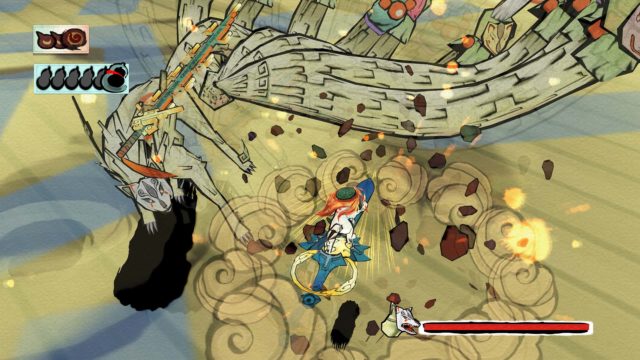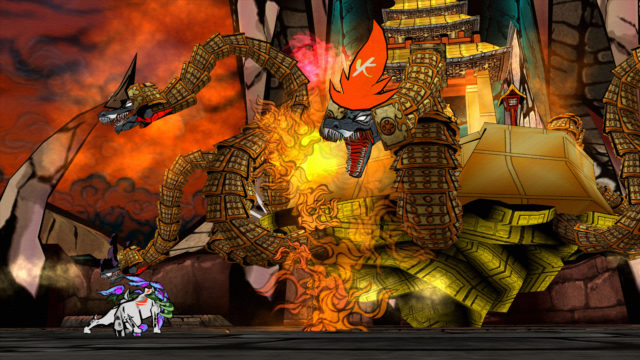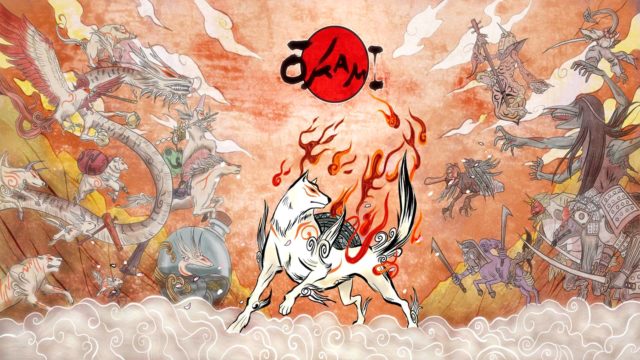Stunning presentation that employs cel-shading to replicate the look and feel of Japanese sumi painting; historically authentic soundtrack perfectly compliments the gameplay; fun combat; engaging, 40-hour long quest
Combat can be a little too easy, with only the bosses offering any real challenge
In the early 2000s, Capcom had a small development house under its wing that went by the name Clover Studio. Although it shuttered years ago, with many of its expatriates going on to form Platinum Games, Clover continues to get a lot of posthumous praise from fans and critics alike for its works. While the developer initially was meant to create games separate from Capcom’s various established franchises, Clover eventually became synonymous with its myriad Viewtiful Joe titles. Yet, there’s another game that Clover created which has shown some incredible staying power over the years. That game is God Hand Ōkami.
Released in 2006, Ōkami has gone on to countless other platforms in the years since, including a port on Wii which integrated motion controls into the title. In more recent times, Ōkami has gotten a high definition facelift and been rechristened as Ōkami HD. It was made available on PlayStation 3 and 4, as well as Xbox One, but it’s never been on a Nintendo platform… until now! This also marks the first time that Ōkami has been playable as a portable experience. It’s a welcome addition to the Switch ecosystem, but after 12 years, is Ōkami still worthy of a play?
The answer is: of course! Ōkami is a third-person adventure game that frequently gets compared to The Legend of Zelda series. While I think those comparisons are slightly overblown, there’s no denying the similarities of a large, open game world to explore, countless side-characters and sidequests to engage in, puzzle solving, and sword swinging. Ōkami differs in several key ways, however, and has a flavor very distinct to Zelda’s, as a result. It might have been a long time ago that Ōkami first released, but masterful game design never grows stale.
Ōkami revolves around the deity wolf Amaterasu and her minute companion Issun, a “wandering artist” who’s roughly the size of a mushroom. Issun acts as the intermediary voice between Amaterasu, the player, and the denizens of the game world. Issun also provides direction and guidance, explaining the various abilities that Amaterasu has access to as well as giving players insight as to where to go next. While Issun does act as the navigator in Ōkami, his presence is never overbearing, and he also injects quite a bit of humor into the game, which is a nice bonus.
Ōkami is firmly rooted within Japanese folklore and mythology, making multiple references to various deities and spirits from the region. The plot revolves around the resurrection of an enormous, multi-headed dragon named Orochi whose only goal is the destruction of the land of Nippon. With the beast’s return, the sun goddess Amaterasu has manifested as a white wolf intent on stopping the impending end of the world. The story spans some 40 hours of gameplay and provides a litany of thrills and twists throughout. How Clover managed to so successfully mix Japanese antiquity with contemporary humor, drama, and action, I’ll never know.
The ties to traditional Japanese culture aren’t limited to the narrative, as they’re also integral to the visual design of Ōkami. In the 2000s there were a rash of games that employed a “cel-shaded” style of graphics. It’s a 3D rendering technique that produces character models and environments that look “flat” so as to replicate the appearance of a cartoon or comic book. There were a number of titles in the mid to late 2000s that utilized cel-shading, like Ultimate Spider-Man and the Sly Cooper trilogy on PlayStation 2, but the most famous example (and most relevant to Nintendo fans) is The Legend of Zelda: The Wind Waker. Yet, while Wind Waker certainly put cel-shading to great use, Ōkami was arguably much more creative with its implementation.

Ōkami‘s art direction is designed to mimic the style of Japanese sumi-e painting. Sumi-e, or ink wash painting, has roots throughout East Asia— generally made by literati and other scholarly types, these pieces are crafted with various concentrations of ink and bold, confident brush strokes. Cel-shading proved to be the perfect vehicle for visually recreating the sumi-e style and also tied in thematically to Ōkami‘s links to Japanese fables and Shintoism. Now in HD, the graphics look better than ever. Although some of the limitations of 2002 do crop up, like the occasional odd bits of geometry and pop-in that are still present, they’re minimally intrusive. Ōkami is beautiful, and its numerous flourishes like bursts of blooms trailing behind Amaterasu as she runs are even more mesmerizing in 1080p.
The soundtrack of Ōkami is similarly bound with tradition, with a variety of Japanese instruments like biwa, shamisen, and koto included in the music for yet another layer of historical authenticity. As is the case with virtually every other element in Ōkami, nothing about the presentation is perfunctory, with every piece in some way riffing off of or enhancing another. The music here helps to capture the atmosphere of a fantastical version of feudal Japan while also serving to underscore and amplify what’s happening on-screen.

Being the brainchild of developer Hideki Kamiya, known the world over for Devil May Cry and Bayonetta, it’s little wonder that Ōkami places a fairly heavy emphasis on its combat. Amaterasu can obtain a variety of different weapons as well as consumable items that grant a number of buffs during battles. As the game progresses, she becomes a veritable battering ram, ripping through her foes like a scythe through so much wheat. The only unfortunate drawback here is that the battles can sometimes feel too easy, with enemy AI that apparently would prefer walks on the beach to brawling. Thankfully, the bosses sprinkled throughout Ōkami make up for any deficiencies amongst the rank and file baddies, but the spike in difficulty can sometimes be jarring.
Fighting is accomplished via the use of the Celestial Brush, a divine paint brush that allows Amaterasu to freeze time and turn the world into her canvas. Whether using the control stick, motion controls, or the touch screen while in handheld mode, the player manipulates the brush to slice through enemies. Amaterasu can also strike foes directly, which, combined with the brush strokes, makes combat in Ōkami incredibly fluid and fast. The Celestial Brush plays another crucial role throughout the game, as it can be used to fill-in pieces of the environment, change the time of day, and much, much more. New abilities for the brush are unlocked as Amaterasu makes her way through the adventure, and by the endgame she very much feels like a goddess.

Exploration and puzzle solving are the other draws of Ōkami. As noted above, comparisons are frequently drawn between Ōkami and Zelda, as both employ a similar structure of progression. Although Ōkami has far less traditional “dungeons” compared to Zelda, the ones that are here are smartly designed and memorable. There’s also plenty of scouring for unlockables that will grant Amaterasu passage to new areas, new secrets, and so on. Puzzles here aren’t especially taxing, but the use of the Celestial Brush adds a fresh coat of paint to otherwise familiar trappings. There are also sidequests to partake in, further serving to amp up Amaterasu’s arsenal of weapons, items, and abilities.
Again, I can’t emphasize strongly enough what a delight Ōkami was, is, and will always be. Clover might not have been given the chance to make many games while it existed, but the legacy that it cultivated in such a short amount of time is remarkable. Ōkami was not a high-selling game in 2006, but with each new port its fanbase grows. This Switch release is a highpoint, as it merges multiple different methods of control into one version, and can be played anywhere at any time. Ōkami is one of the highest expressions of a video game as art, further blurring the lines between the two. It’s not just a delightful game, it’s also a historically important one, and everyone owes it to themselves to experience Ōkami, either again or for the first time.




 ShareThis
ShareThis





